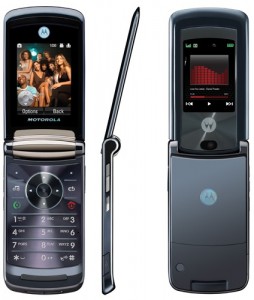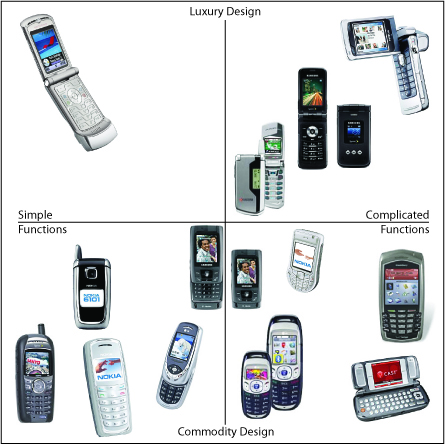Design That Moves Business: The Motorola RAZR Effect
By guest authors Charley Bush and Kathy Hwang of brand, design and business strategy consultancy 3Strand Innovation
If a picture is worth 1,000 words, a great design is worth a 70% stock boost.
What lies in store for the future of mobile phones? Will it continue to be Apple’s iPhone that drives innovation? Or will the new Google G1 phone take the lead?
If we look back at design icons that have changed the mobile phone marketplace, the Motorola RAZR pops up as one of the prime examples.

Motorola’s use of the RAZR serves as a great example of the best and the worst of innovation. It used great technology, it had a bold and expressive aesthetic, and it succeeded in the marketplace. When it entered the mass market in 2005, Motorola CEO Edward J. Zander proudly announced in his Q3 2005 conference call that the RAZR “just knocked the cover off the ball in unit sales, operating earnings and market shares and every area that we measured.” And with good reason. The “RAZR boom”, as it was referred to, not only raised sales and brand awareness, but also brought Motorola a stock boost of nearly $10 per share.
(Motorola stock performance: 2005-2006)
However the “worst” is that everything that made the RAZR a success is being lost by the company, just a few years later. Nowadays, even Motorola does not seem to be able to follow its own example of innovation with its new product lines.
When the RAZR first came out, you could tell that there was something about it. When you opened the phone and saw the acid-etched keypad light up with a soft blue glow, it prompted a visceral response: COOL! That moment in time, when design can evoke that response in customers, is what we call the Exclamation Point or X-Point. It’s when a business uses the elements of delight and surprise to turn the customer’s brain into an emotionally-powered machine bent on owning one of these gadgets.
How did Motorola create this X-Point? Looking at the history behind their development of the RAZR, we see this general approach:
1) Start with a human-centered ideal: make the world’s thinnest phone (one that you won’t even notice is in your pocket).
2) Come up with ideas in an unconventional setting (in Motorola’s case, at a local pub over drinks).
3) Hold off the peanut gallery, while trying to do something new.
4) Work collaboratively, without team silos.
5) Let go of any “sacred cows”.
6) Adapt to problems that arise and hold firmly to the original design intent.
We’ll get deeper into this approach in part 2, but to begin with, let’s ask the question: what is it that made the RAZR so damn cool?
Looking back to 2004-2005, there was definitely a cell phone war over what would be the next killer gadget on the market. We created the following chart to show the hole in the market that Motorola found between simplicity of function and luxury design. For the Motorola team, it was not just about what the RAZR could do. There were plenty of other phones with more functions and video capabilities. Rather, the RAZR stood out because of what it looked like. It was designed to be something beautiful and jewelry-like.

The phone was, at the time, impossibly thin. Looking at the profile, you can notice the subtle application of color changes that give the phone an even thinner appearance. The RAZR used proportions, color and material to appear elegantly thin, yet aggressive with its sharper edges and corners. This was at a time when most other cell phones were starting to resemble squashed jellybeans. The RAZR used design to create the brand “thin is cool.” And when it hit the marketplace, it made most other phones look like they should have been handed out with an old Ford Taurus.
Today this market hole has quickly been filled by other companies. Yet the lessons are found in the process they used to get there. Please join us for the following 2 sections, where we dive deeper into this.
This segment is a part in the series : Design That Moves Business
. The Motorola RAZR Effect
. The Motorola RAZR Effect (Part 2)
. The Motorola RAZR Effect (Part 3)
. An Unusual Place for Design
. What exactly is “customer-centric”?
Featured Videos
Can 1M/1M Help Me Raise Money?
How Does 1M/1M Democratize Entrepreneurship Education?
How Does 1M/1M Democratize Management Consulting?
When Is The Right Time To Join 1M/1M?
Can 1M/1M Help Me With Business Development?
Can 1M/1M Help Me With Market Sizing?
Can 1M/1M Help Me Validate My Product?
Will I Have Private 1-on-1 Sessions In 1M/1M?
How Does 1M/1M Help Entrepreneurs Connect With Silicon Valley?
Mentoring or Consulting?
Why Does 1M/1M Charge $1000 a Year?
Why Does 1M/1M Partner With Local Organizations?
Why Don\’t Mentoring Networks Work?
Why Is It Important To Study With 1M/1M Now?
Dan Stewart Story
Vikrant Mathur Story

